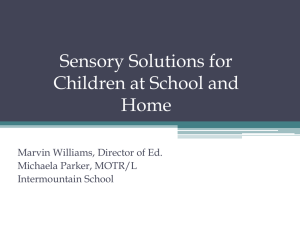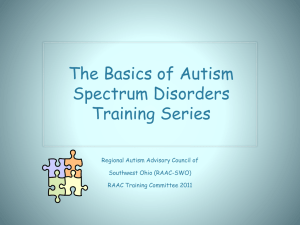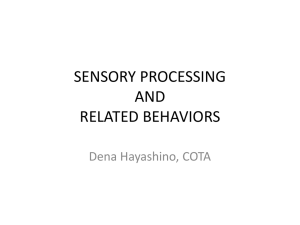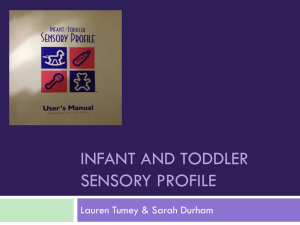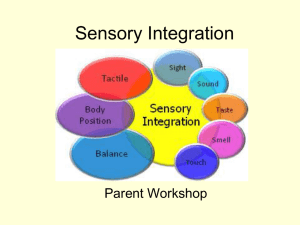SENSORY PROCESSING Making the World a More Sensorially
advertisement
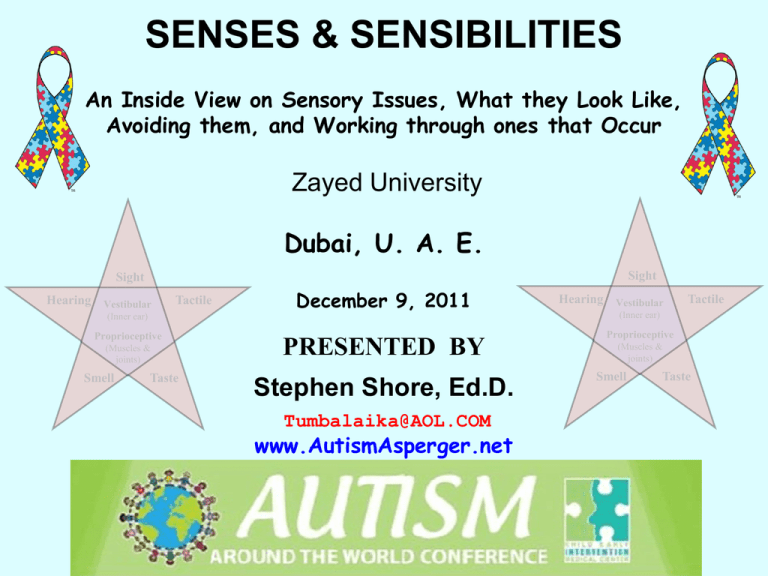
SENSES & SENSIBILITIES An Inside View on Sensory Issues, What they Look Like, Avoiding them, and Working through ones that Occur Zayed University Dubai, U. A. E. Sight Sight Hearing Vestibular Tactile (Inner ear) Proprioceptive (Muscles & joints) Smell Taste December 9, 2011 PRESENTED BY Stephen Shore, Ed.D. Tumbalaika@AOL.COM www.AutismAsperger.net Hearing Vestibular Tactile (Inner ear) Proprioceptive (Muscles & joints) Smell Taste EXPERIENCING SENSORY ISSUES • PROVIDING AN INSIDE VIEW • 2 S E N S O R Y O V E R L O A D A C T I V I T Y In groups of 5, each person plays a specific role. Start when given the signal Person #1: You play the role of a person with autism. Your job is to listen to what Person #5 is reading to you so you can take a test on the material. Try to ignore everyone else. Person #2: Stand behind the student playing the part of someone with autism. Rub the edge of an index card (or piece of cardboard) against the back of their neck. You do not need to rub hard, but keep doing it over and over. Person #3: Grab a book (any book will do), lean close to Person #1 and read in a loud voice the entire time. Person #4: Pat Person #1 on the head and shoulder the entire time. Person #5: Using a normal voice, read a paragraph to Person #1 then ask them questions about what you read. Do NOT try to drown out the other noises. Have all the group members take a turn being Person #1. • How did it feel to have so much commotion going on? • Did it make you want to scream and run away? • Was Person #1 able to concentrate on the paragraph being read? • What might have helped? Adcock, B., & Remus, M. (2006). Disabilities awareness activity packet: Activities and resources for teaching students about disabilities. Possibilities, inc, p. 4. Available on February 19, 2011 at http://www.vcu.edu/partnership/C-SAL/downloadables/PDF/DisabilityAwarenessPacket.pdf. SENSORY ISSUES What are they? 4 SENSORY PROCESSING Making the World a More Sensorially Friendly Place "Sensory integration is the neurological process of organizing the information we get from our bodies and from the world around us for use in daily life" (Kranowitz, 1998, p. 42). According to Dr. Ayres, "Over 80% of the nervous system is involved in processing or organizing sensory input, and thus the brain is primarily a sensory processing machine" (Kranowitz, 1998, p. 42). The brain modulates this input which in turn guides our activity level. Activity may be mental, physical or emotional. 5 SENSORY PROCESSING Making the World a More Sensorially Friendly Place "Sensory integration dysfunction is the inability to process information received through the senses" (Kranowitz, 1998, p. 8). … inefficient neurological processing. "The brain cannot analyze, organize, and connect -- or integrate -- sensory messages" (Kranowitz, 1998, p. 8). Not brain damage but rather “indigestion” or a “traffic jam” of the brain (Kranowitz, 1998, p. 50). Child may be hyper, hypo, or alternate between the sensitivities at any given time. 6 INNER AND OUTER SENSES S E N S O R Y V I O L A T I O N S Sight Hearing Vestibular Tactile (Inner ear) Proprioceptive (Muscles & joints) Smell Taste Vestibular: Hypo —> Spinning/Hyper —> Gravitational Insecurity Proprioceptive: Deep pressure, Under mattresses, Weighted blankets Love airplanes but they mess w/Vest & Prop senses Brave little kids 7 SENSORY PROCESSING Making the World a More Sensorially Friendly Place C A S E S T U D Y Keith: The Light Switcher Seemingly at random during class, Keith would often run over to the light switch to turn it off. A frequent visitor of the principal’s office his response was “I don’t like those lights!” TASK You, as a member of Keith’s team, please… 1. Arrive at a possible explanation of this behavior, and, 2. what might be done about it? 8 CHARACTERISTICS OF CHILDREN WITH AUTISM SPECTRUM CONDITIONS Overly sensitive to loud noises… Difficulty with hair washing and brushing… Only likes certain types of clothing… Adapted from Myles, Cook, Miller, Rinner & Robbins. (2000). Asperger Syndrome and sensory issues : Practical solutions for making sense of the world. Shawnee Mission, KS: Autism Asperger Publishing. P. 5. 9 SENSORY PROCESSING Making the World a More Sensorially Friendly Place 10 SENSORY PROCESSING Making the World a More Sensorially Friendly Place C A S E S T U D Y Robert: The Boy Who Threw Up in Gym Upon entering the gym for physical education Robert would throw up. His aide would state “Throwing up in gym is unacceptable behavior. You need to go to time out.” TASK You, as a member of Robert’s team, please… 1. Arrive at a possible explanation of this behavior, and, 2. what might be done about it? 11 ASSESSMENT OF SENSORY ISSUES 12 SENSORY PROCESSING Making the World a More Sensorially Friendly Place SENSORY PROFILE BY WINNIE DUNN & CATANNA BROWN A. Taste/Smell Processing B. Movement Processing Low Registration Sensation Seeking Sensory Sensitivity Sensation Avoiding C. Visual Processing D. Touch Processing E. Activity Level F. Auditory Processing 13 SENSORY PROCESSING Making the World a More Sensorially Friendly Place SENSORY PROFILE BY WINNIE DUNN & CATANNA BROWN Low Registration • High thresholds + passive self-regulation Sensation Seeking • High thresholds + active regulation • Don’t notice what is going on around them, • Seekers add movement, touch, sounds, and because brain isn’t activating enough visual stimuli to every life event to increase sensory input • May be withdrawn or difficult to engage • Need extra sensory input to be able to participate in school activities Sensory Sensitivity • Low thresholds + passive self-regulation • Tend to be more hyperactive, distracted, and easily upset • Have difficulty completing tasks as new stimuli keep capturing their attention • Frequent disruptions in routine make it difficult to learn • May lack caution in play, display excitability, and engage in impulsive behavior Sensation Avoiding • Low thresholds + active self-regulation • Children actively work to reduce input in order to avoid discomfort • Resistant and unwilling to participate in activities, especially new ones 14 SENSORY PROCESSING Making the World a More Sensorially Friendly Place WINNIE DUNN’S CONCEPTUAL FOR SENSORY PROCESSING High Thresholds Low Registration Sensory Seeking Passive Strategy Active Strategy Sensory Avoiding Sensory Sensitivity Low Thresholds 15 SENSORY PROCESSING Making the World a More Sensorially Friendly Place C A S E S T U D Y Jeri: The Girl Who Started Fights in Line While waiting in line, ordered by height, Jeri would often hit other students and be accused of starting fights. Her usual response: “He or she bumped or hit me first!” TASK You, as a member of Jeri’s team, please… 1. Arrive at a possible explanation of this behavior, and, 2. what might be done about it? 16 TELESCOPING TO ADULTHOOD 17 SENSORY ISSUES 18 SENSORY ISSUES & RELATIONSHIPS • Dating? • Hygiene? • Intimate Relationships? 19 SENSORY ISSUES & EMPLOYMENT 20 SENSORY PROCESSING Making the World a More Sensorially Friendly Place Matching Needs to Possible Employment Positions Personal Characteristics Preferred Job Attributes Possible Positions Deficit in verbal and nonverbal communication Few communication requirements Stock shelves Challenges in socialization Limited contact with public, more solitary job duties Filing, sorting, stapling paper shredding, after-hours cleaning Unusual response to sensory stimulation Provider of preferred sensory input, ability to avoid noxious sensory stimulation Hanging clothes, washing cars (for those enjoying that type of tactile input Difficulty with change and transition Few changes,stable work environment,little staff turnover, same work task all day Small business,family business, assembly line Adapted from Shore, S. & Rastelli, L. (2006). Understanding autism for dummies. New York: Wiley. 21 SENSORY PROCESSING Making the World a More Sensorially Friendly Place Matching Needs to Possible Employment Positions Personal Characteristics Preferred Job Attributes Possible Positions Strong visual-motor skills Requires good visual-motor skills Small-parts assembly, manufacturing, printing Behavior challenges Few antecedents to challenging behaviors, with situations where possible problems don’t endanger others Situations where behavior doesn’t cause dangerous situations; avoid factories or jobs using heavy machinery Savant skills Responsibilities capitalizing on these strengths Matching stock numbers to packing lists, mathematically oriented positions for those with good math skills Adapted from Shore, S. & Rastelli, L. (2006). Understanding autism for dummies. New York: Wiley. 22 www.autismasperger.net 23



